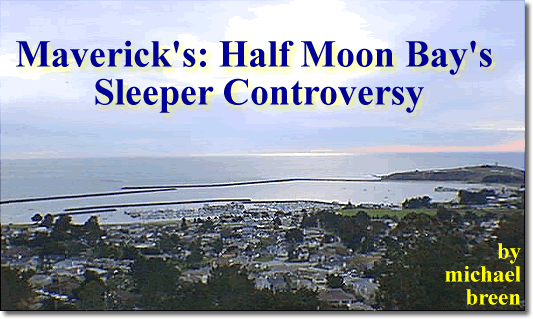
Pumpkins and Christmas trees were once all that Half Moon Bay, California, was known for. Today, it is known as home of the worldís largest surfable waves.
Ten years ago people didn't believe Jeff Clark when he said there were 30-foot waves just outside of Pillar Point Harbor in Half Moon Bay. It wasn't until 1992, in a June issue of Surfer Magazine, that Maverickís, as the surf spot is known, was finally revealed to the world as the largest wave in California, and arguably the largest in the world.
The June '92 Surfer Magazine cover shot of Half Moon Bay surfer Darin Bingham at Maverickís changed the little town forever. "It put Half Moon Bay on the map more than anything ever did," says Eric Nelson, a surf-video producer and long-time resident of Half Moon Bay. "Now, when someone in the world hears of Half Moon Bay, they think of Maverickís."
But exposure has brought inevitable change to the once-quiet town, and not everyone likes it. "It's growing like gang busters," says John Zents, a 15-year resident who moved to the town to find peace and quiet. "We've been discovered and Maverick's had much to do with that."
Located just 20 miles south of San Francisco off scenic Highway 1 -- a half hour's drive from the City and about 45 minutes from Silicon Valley -- Half Moon Bay is a land developerís dream. Right now there are only two two-lane roads in and out of the town: Highway 1 and Highway 92.
Residents have vehemently opposed building roads larger than two lanes and development plans that could disturb the balance of nature. The Build Tunnel, We Will Dig It bumper sticker, opposing the construction of a large highway bypassing Devilís Slide, has been the most visible battle cry of Half Moon Bay environmentalists for years.
Nevertheless, some have seen positive results from the exposure Maverickís has brought. "The restaurants are always filled with touring pros during the winter months, which in the past have always been dead months," says Jeff Clark, the man who helped show Maverickís to the world in 1992. "Every business on the coast side has been helped by the exposure." Clark is the owner of Mavericksís Surf Shop in Half Moon Bay.
But others lament the changes taking place in Half Moon Bay. "I think the kids around here are the ones really losing out," says Bingham, 33. "They will probably never get to surf in the same kind of environment that we grew up in."
Six years ago the Half Moon Bay Harbor District, which manages the land around Maverickís, placed a parking lot and a new path leading directly to the cliff where tourists and surfers alike could view the wave. "We now get 10,000 visitors a year coming to see Maverickís. There was maybe a third of that number coming to visit the area five years ago," says Dan Temko, Half Moon Bay's harbor master.
Clearly, opinions vary about whether the exposure from Maverickís has been good or bad for the town.
"What are we going to do?" asks Clark. "We live in a place that is truly awesome. I would like to see the city move towards making it so more people can come and see the beauty, so that they might also want to help preserve it. Are we so selfish that we canít share a wave? Is that what this is all about?"
Maverickís, a recent documentary made by San Franciscan Grant Washburn, has brought the wave to the big screen and increased the hype surrounding it. But most surfers donít seem very concerned. Says Washburn, himself a surfer, "Itís still the same group of guys that always shows up here. It really hasnít changed the spot all that much. Half Moon Bay is a beautiful area, and that's why it is starting to become more noticed."
Currently the controversy is low-keyed, and the only access to town is still two two-lane roads. But given time and the right conditions, it could become as big as the fabled wave itself.
